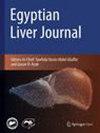Epidemiology of acute liver failure in Egyptian children
IF 0.7
Q4 GASTROENTEROLOGY & HEPATOLOGY
引用次数: 0
Abstract
Acute liver failure (ALF) is a serious condition that refers to the development of synthetic function impairment after severe acute liver injury in an individual without pre-existing liver disease. Understanding the epidemiology of ALF in children constitutes a cornerstone in its preventive and treatment plans. Nevertheless, there is a lack of information about its epidemiology in Egypt. The aim of this study was to assess the epidemiologic data of ALF in Egyptian children. The medical records of children with ALF aged from 6 months to 18 years who were admitted from 2015 to 2020 were analyzed to identify the patient’s epidemiologic, laboratory, and investigational data together with their outcome. The study included 154 patients who fulfilled the definition of ALF were included. Their age ranged from 7 months to 17 years, with a median of 5.8 years. Hepatitis A virus (HAV) was the most commonly identifiable etiology (37.7%). Mortality was the outcome for 73 patients (47.4%). The prognostic factors associated with mortality were elevated international normalized ratio (INR), total bilirubin (TB), creatinine, and ammonia levels at presentation with cutoff values (2.97, 21.15, 0.385, and 212, respectively). Hepatitis A virus is the most commonly identified etiology of ALF in Egyptian children. The mortality rate is high, and most of the deaths occurred early in the first 5 days of admission. So, early preparation for liver transplantation is recommended. Higher values of INR, TB, and creatinine above the cutoff levels at presentation may be potential markers for predicting death in affected children.埃及儿童急性肝功能衰竭的流行病学
急性肝功能衰竭(ALF)是一种严重的疾病,是指没有肝脏疾病的人在严重急性肝损伤后出现合成功能障碍。了解儿童急性肝衰竭的流行病学是其预防和治疗计划的基石。然而,在埃及却缺乏有关其流行病学的信息。本研究旨在评估埃及儿童 ALF 的流行病学数据。研究人员对 2015 年至 2020 年期间收治的 6 个月至 18 岁 ALF 儿童的病历进行了分析,以确定患者的流行病学、实验室和调查数据及其结果。研究共纳入154名符合ALF定义的患者。他们的年龄从 7 个月到 17 岁不等,中位数为 5.8 岁。甲型肝炎病毒(HAV)是最常见的病因(37.7%)。73名患者(47.4%)最终死亡。与死亡率相关的预后因素是发病时国际标准化比值(INR)、总胆红素(TB)、肌酐和氨水平升高,临界值分别为 2.97、21.15、0.385 和 212。甲型肝炎病毒是埃及儿童 ALF 最常见的病因。死亡率很高,而且大多数死亡发生在入院后的头 5 天。因此,建议尽早做好肝移植准备。发病时 INR、TB 和肌酐值高于临界值可能是预测患儿死亡的潜在指标。
本文章由计算机程序翻译,如有差异,请以英文原文为准。
求助全文
约1分钟内获得全文
求助全文

 求助内容:
求助内容: 应助结果提醒方式:
应助结果提醒方式:


